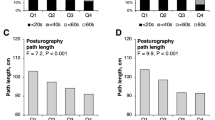Abstract
Background and aims: Chair rise performance, which is simple to assess in a home or clinic setting, has been used as a method of predicting leg power deficit in older adults. More recently, chair rise performance has been assessed in younger populations as a baseline for assessment of subsequent age-related declines in function and power. However, as rising from a chair repeatedly not only requires lower limb strength and power but also good balance and coordination, it may not be purely a measure of leg power especially among these younger, well functioning groups who are yet to experience agerelated declines and deficits in function. The aim of this study was to assess whether chair rise performance can be considered as a predictor of leg power, and hence of deficits in this, in men and women in mid-life. We assessed the relationship of chair rise performance with leg extensor power (LEP), measured using the Nottingham Power Rig (NPR), and with standing balance performance. Methods: LEP was measured in a clinic setting in a sub-sample of 81 men and 93 women from the MRC National Survey of Health and Development, a nationally representative cohort born in Britain in 1946. The time taken to rise from a chair 10 times and standing balance time were assessed during home visits at the same age. Results: Increasing LEP was associated with better chair rise performance among those who completed 10 chair rises in ≥15 seconds, after adjustment for body size (p=0.008). Better standing balance performance was associated with better chair rise performance in men, but not women. Conclusions: That LEP and standing balance are both related to chair rise time in men suggests that chair rise time should not be thought of purely as a proxy measure of leg power in middle-aged populations. This has implications for longitudinal studies which want to study age-related decline in chair rise performance.
Similar content being viewed by others
References
Guralnik JM, Simonsick EM, Ferrucci L et al. A short physical performance battery assessing lower extremity function: association with self-reported disability and prediction of mortality and nursing home admission. J Gerontol 1994; 49: M85–94.
Proctor DN, Fauth EB, Hoffman L et al. Longitudinal changes in physical functional performance among the oldest old: insight from a study of Swedish twins. Aging Clin Exp Res 2006; 18: 517–30.
Al Snih S, Markides KS, Ottenbacher KJ, Raji MA. Hand grip strength and incident ADL disability in elderly Mexican Americans over a seven-year period. Aging Clin Exp Res 2004; 16: 481–6.
Cesari M, Onder G, Zamboni V et al. Physical function and self-rated health status as predictors of mortality: results from longitudinal analysis in the ilSIRENTE study. BMC Geriatr 2008; 8: 34.
Morita M, Takamura N, Kusano Y et al. Relationship between falls and physical performance measures among community-dwelling elderly women in Japan. Aging Clin Exp Res 2005; 17: 211–6.
Guralnik JM, Branch LG, Cummings SR, Curb JD. Physical performance measures in aging research. J Gerontol Med Sci 1989; 44: M141–6.
Guralnik JM, Ferrucci L, Simonsick EM, Salive ME, Wallace RB. Lower-extremity function in persons over the age of 70 years as a predictor of subsequent disability. N Engl J Med 1995; 332: 556–61.
Bassey EJ, Short AH. A new method for measuring power output in a single leg extension: feasibility, reliability and validity. Eur J Appl Physiol Occup Physiol 1990; 60: 385–90.
Allied Dunbar national fitness survey. Main findings: A report on activity patterns and fitness levels. London: The Sports Council and Health Education Authority, 1992.
Bassey EJ, Fiatarone MA, O’Neill F, Kelly M, Evans WJ, Lipsitz A. Leg extensor power and functional performance in very old men and women. Clin Sci 1992; 82: 321–7.
Skelton DA, Greig CA, Davies JM, Young A. Strength, power and related functional ability of healthy people aged 65–89 years. Age Ageing 1994; 23: 371–7.
Bean JF, Leveille SG, Kiely DK, Bandinelli S, Guralnik JM, Ferrucci L. A comparison of leg power and leg strength within the InCHIANTI study: Which influences mobility more? J Gerontol Med Sci 2003; 58A: 728–33.
Bean JF, Kiely DK, Herman S et al. The relationship between leg power and physical performance in mobility-limited older people. J Am Geriatr Soc 2002; 50: 461–7.
Wadsworth MEJ, Butterworth SL, Hardy RJ et al. The life course prospective design: an example of benefits and problems associated with longevity. Soc Sci Med 2003; 57: 2193–205.
Kuh D, Hardy R, Butterworth S et al. Developmental origins of midlife physical performance: evidence from a British birth cohort. Am J Epidemiol 2006; 164: 110–21.
Kuh D, Bassey EJ, Butterworth S, Hardy R, Wadsworth MEJ. Grip strength, postural control, and functional leg power in a representative cohort of British men and women: Associations with physical activity, health status, and socioeconomic conditions. J Gerontol Med Sci 2005; 60A: 224–31.
Ferrucci L, Guralnik JM, Buchner D et al. Departures from linearity in the relationship between measures of muscular strength and physical performance of the lower extremities: The Women’s Health and Aging Study. J Gerontol Med Sci 1997; 52A: M275–85.
Kuh D, Cooper R, Hardy R, Guralnik J, Richards M. Lifetime cognitive performance is associated with midlife physical performance in a prospective national birth cohort study. Psychosom Med 2009; 71: 38–48.
Lord SR, Murray SM, Chapman K, Munro B, Tiedemann A. Sitto- stand performance depends on sensation, speed, balance, and psychological status in addition to strength in older people. J Gerontol Biol Sci Med Sci 2002; 57: M539–43.
Author information
Authors and Affiliations
Corresponding author
Rights and permissions
About this article
Cite this article
Hardy, R., Cooper, R., Shah, I. et al. Is chair rise performance a useful measure of leg power?. Aging Clin Exp Res 22, 412–418 (2010). https://doi.org/10.1007/BF03324942
Received:
Accepted:
Published:
Issue Date:
DOI: https://doi.org/10.1007/BF03324942




